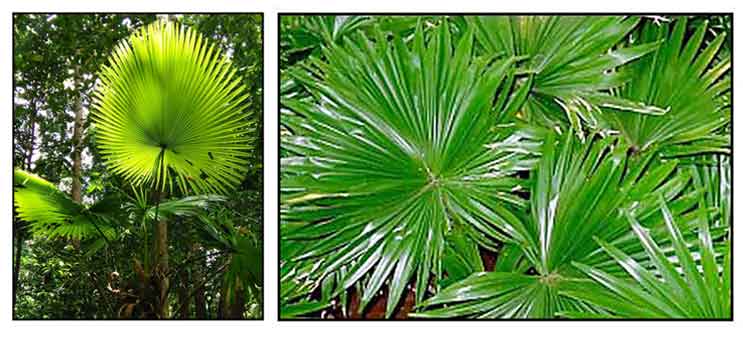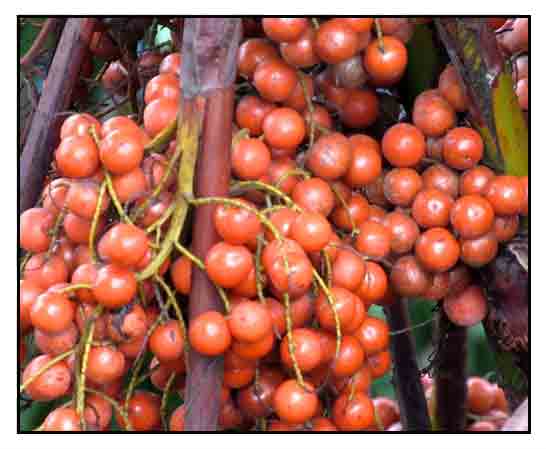
Family • Arecaceae
Anahaw
Saribus rotundifolius (Lam.) Blume
FAN PALM
Yuan ye pu kui
| Scientific names | Common names |
| Corypha rotundifolia Lam. | Anahaw (Tag.) |
| Licuala rotundifolia (Lam.) Blume | Bulos (Bik.) |
| Livistona altissima Zoll. | Luyong (Tag.) |
| Livistona microcarpa Becc. | Payoong-payong (Benguet) |
| Livistona mindorensis Becc. | Anahaw palm (Engl.) |
| Livistona robinsoniana Becc. | Fan palm (Engl.) |
| Livistona rotundifolia (Lam.) Mart. | Footstool fan (Engl.) |
| Livistona rotundifolia var. luzonensis Becc. | Java fan palm (Engl.) |
| Livistona rotundifolia var. microcarpa (Becc.) Becc. | Rotund palm (Engl.) |
| Livistona rotundifolia var. mindorensis (Becc.) Becc. | Round-leaf fountain palm (Engl.) |
| Saribus rotundifolius (Lam.) Blume | Table fan (Engl.) |
| Saribus rotundifolius (Lam.) Blume is an accepted species. KEW: Plants of the World Online | |
| Other vernacular names |
| CHINESE: Yuan ye pu kui, Gao bei pu kui. |
| FRENCH: Palmieer évantail de Java. |
| GERMAN: Livistonie, Waldpalme, Serdang-Schirmpalme, Fächer-palme. |
| INDONESIAN: Weka. |
| ITALIAN: Palma parasole. |
| MALAYSIAN: Sadeng, Serdang, Serdang daun bulat. |
| NORWEGIAN: Dronningpalmae. |
| PORTUGUESE: Palmeira-leque. |
| SPANISH: Palmere de hoja redonda, Palmera de escabel, Palma de escabel. |
| THAI: Paam chawa, Paam yawa. |
Updatec December 2023
January 2019
![]()
 |
PHOTOS / ILLUSTRATIONS |
| IMAGE SOURCE: / Illustration: Saribus rotundifolius as synonym Livistonia altissima / Louis van Houtte / Botanicus / Public Domain / Wikipedia |
| OTHER IMAGE SOURCE: / Photograph: File: Saribus rotundifolius fruit / 31 May 2017 / Malcolm Manners / Lakeland, FL, USA / Creative Commons Attribution 2.0 / click on image to go to source page / Wikimedia Commons |
| OTHER IMAGE SOURCE: / Photograph / Leaves: File: Livistona rotundifolius / © Paresh Chun / Mahim, Mumbai City, Maharashtra, India / 10.05.2015 / click on image to go to source page / Butterflies of India |
| OTHER IMAGE SOURCE: Spines on margins of petiole of young plant of Saribus rotundifolius / Dariusz Kowalczyk / CC BY-SA 4.0 / click on image or link to go to source page / Wikipedia |
| OTHER IMAGE SOURCE: Saribuw rotundifolius palm in forest understory in Tangkoko Nature Reserve, Sulawesi / T R Shankar Raman / CC BY-SA 3.0 / click on image or link to go to source page / Wikipedia |
Additional
Sources and Suggested Readings |
• |
DOI: It is not uncommon for links on studies/sources to change. Copying and pasting the information on the search window or using the DOI (if available) will often redirect to the new link page. (Citing and Using a (DOI) Digital Object Identifier) |
| List of Understudied Philippine Medicinal Plants |
| New plant names needed The compilation now numbers over 1,300 medicinal plants. While I believe there are hundreds more that can be added to the collection, they are becoming more difficult to find. If you know of a plant to suggest for inclusion, please email the info: local plant name (if known), any known folkloric medicinal use, scientific name (most helpful), and, if possible, a photo. Your help will be greatly appreciated. |
• |
 |


 Gen info
Gen info
 Uses
Uses